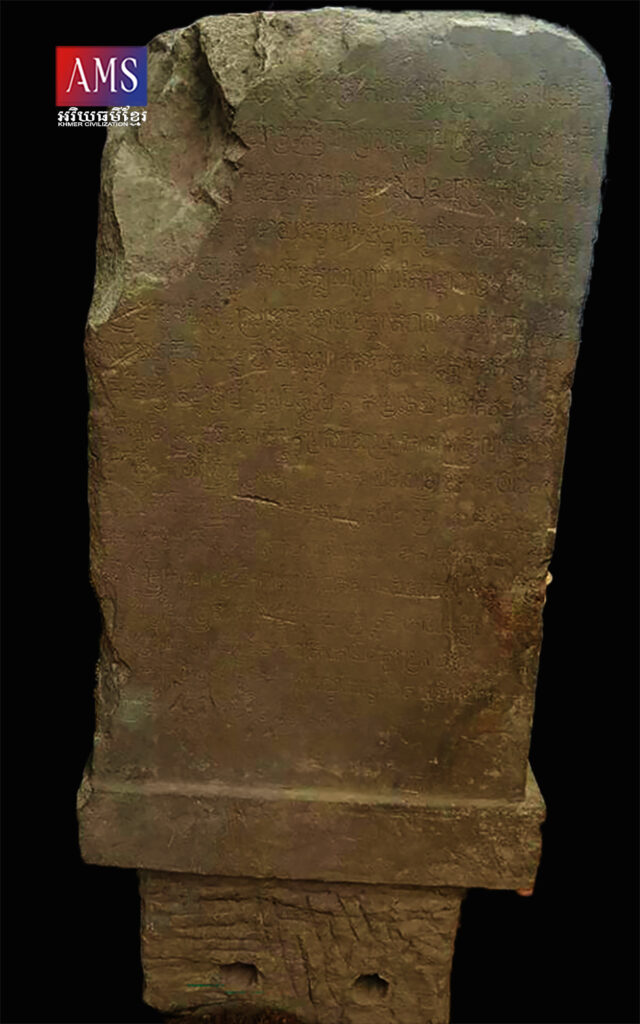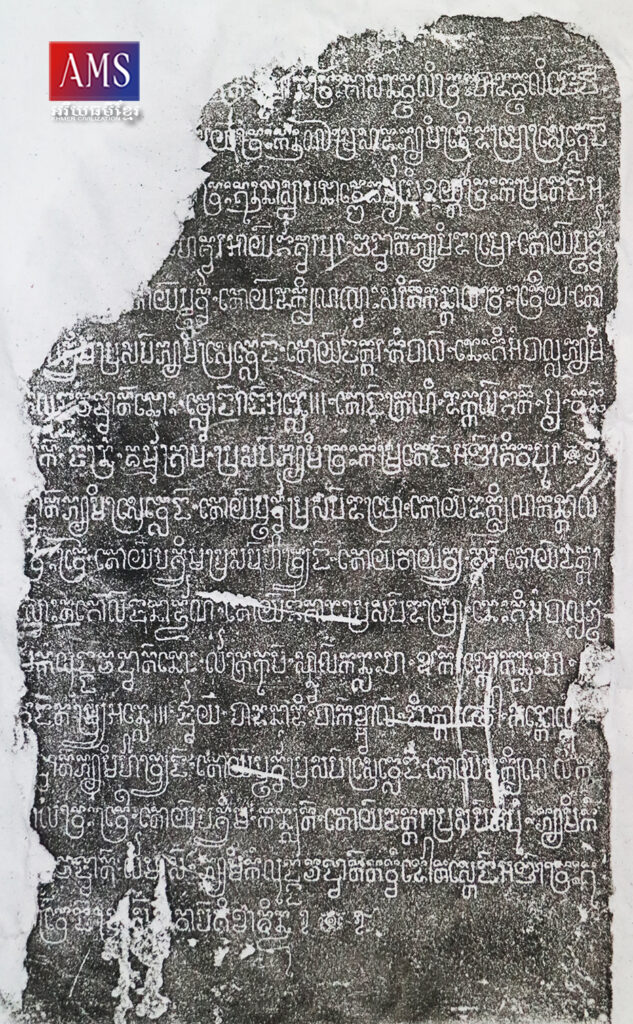នៅថ្ងៃទី៥ ខែមេសា ឆ្នាំ២០១៨ លោក ឡុង ងិល បានរកឃើញសិលាចារឹកមួយផ្ទាំង នាពេលបើកត្រាក់ទ័រ ដើម្បីពូនរងដាំដំឡូងមីនាចម្ការរបស់លោក យ៉ា ប៉ុន ស្ថិតនៅក្នុងភូមិរំចេក ឃុំអន្លង់វែង ស្រុកអន្លង់វែង ខេត្តឧត្តរមានជ័យ។ លោក យាន យ៉ា មន្ត្រីមន្ទីរវប្បធម៌និងវិចិត្រសិល្បៈខេត្តឧត្តរមានជ័យ បានបញ្ជាក់ថានៅក្នុងបរិវេណចម្ការដែលរកឃើញសិលាចារឹកនេះ ជាទីតាំងបុរាណដ្ឋានដែលមានទួលប្រាសាទឥដ្ឋផង។ បន្ទាប់មក នៅថ្ងៃទី៧ ខែមេសា ឆ្នាំ២០១៨ លោក យ៉ា ប៉ុន ក៏បានប្រគល់សិលាចារឹកនេះ ជូនអាជ្ញាធរពាក់ព័ន្ធ ដើម្បីយកទៅរក្សាទុកនៅមន្ទីរវប្បធម៌និងវិចិត្រសិល្បៈខេត្ត។
សិលាចារឹកនេះសាងអំពីថ្មភក់ព័ណ៌ផ្កាឈូក រចនារាងជាបង្គោលសីមា មានកម្ពស់១០៣ស.ម. បន្ទារ៤០.០៥ស.ម. និងកម្រាស់២១ស.ម.។ ផ្នែកខាងក្រោមរចនាជាពន្លួញសម្រាប់តម្កល់សិលាចារឹកនេះនៅលើជើងទម្រ ប៉ុន្ដែគេរកពុំទាន់ឃើញជើងទម្រនេះនៅឡើយទេ។ អត្ថបទចារឹកមានចំនួនមួយផ្ទាំង សរសេរជាអក្សរនិងភាសាខ្មែរសម័យអង្គរ ចំនួន១៧បន្ទាត់ និងដាច់បាត់កាលបរិច្ឆេទ ដោយផ្ទាំងថ្មផ្នែកឆ្វេង បានបែកដោយអន្លើ ជាពិសេសនៅផ្នែកខាងលើពីបន្ទាត់ទី១ដល់ទី៥ ។ យ៉ាងនេះក្ដី ដោយផ្អែកលើអក្ខរក្រម និងស្ថាននាម មានលក្ខណៈស្របគ្នានឹងសិលាចារឹកបន្ទាយស្រី K.៥៧០ និង K.៥៧១ យើងអាចកំណត់បានថា សិលាចារឹកនេះ ស្ថិតនៅក្នុងពាក់កណ្ដាលទី២ នៃស.វ.ទី១០ ក្នុងរាជ្យព្រះបាទជ័យវម៌្មទី៥ (៩៦៨-១០០១)។
អត្ថបទសិលាចារឹកនេះចាប់ផ្ដើមដោយបង្ហាញពីព្រះមហាក្សត្រ បានប្រទានដីភូមិបីកន្លែងដល់ព្រះគ្រូ ដែលលោកបានស្ថាបនាប្រាសាទ(បន្ទាយស្រី)និងធ្វើបុណ្យចំពោះព្រះគម្ដែងអញស្រីត្រីភូវនមហេសូរ នៅឥសូរបូរ។ ដីចង្វាត់បីកន្លែងនោះមានឈ្មោះថាភូមិព្រៃទម្រោ ស្រែភ្លើង និងរហាព្រីង។ អត្ថបទបន្ទាប់ជាការកំណត់ព្រំប្រទល់ដីទាំងបីកន្លែងនោះ។ នៅខាងចុងអត្ថបទជាការបញ្ជាក់ថាដីចង្វាត់ទាំងបីកន្លែងនោះ មិនស្ថិតក្រោម (ការគ្រប់គ្រងរបស់) ស្ដែងអញព្រះគ្រូព្រេងច្រាសនិងវាបសិខាពិន្ទុឡើយ។ ដោយសារកត្តាទម្រង់តួអក្សរក្នុងសិលាចារឹកនេះ ទេវនាម និងស្ថាននាម លោកបណ្ឌិត វង់ សុធារ៉ា បានសន្និដ្ឋានជាបឋមថាសិលាចារឹកនេះ ប្រហែលមានការផ្លាស់ទី(ដោយការលួចឬជួញដូរ)ពីតំបន់ក្បែរប្រាសាទបន្ទាយស្រី ក្នុងបំណងនាំចេញទៅលក់ប្រទេសថៃ។ ចំណុចនេះ យើងត្រូវពិនិត្យពិចារណាទៅលើតឹកតាងនានា ដើម្បីបង្ហាញថាតើសិលាចារឹកនេះ ពិតជាបានផ្លាស់ទីពីទីតាំងណាមួយក្បែរប្រាសាទបន្ទាយស្រី ឬមានទីតាំងដើមនៅតំបន់ដែលរកឃើញសិលាចារឹកនេះផ្ទាល់តែម្ដង។
នៅក្នុងសិលាចារឹកប្រាសាទបន្ទាយស្រី K.៥៧១ បានចារឹកឃ្លាថា «(១)៙បរិគ្រហតម្រតេញ៑កុលបតី·វ្រះអន្រាយ៑ទម្រោអ្នក៑បំរេម្វាយ(២)ស្រូភៃម្វាយ៑តប្ប·មោក៑ឦឝ្វរបុររង្កោរភៃវ្យរ· — (៦)—·វ្រះអន្រាយ៑ស្រេវ្លេង៑រង្កោថ្ល្វង៑(៧)ប្រម្វាយ៑·មោក៑ឦឝ្វរបុរឃ្ឫដអន្ត្វង៑វ្យរ·» មានសេចក្ដីសម្រួលជាភាសាខ្មែរទំនើបថា «បរិគ្រោះ(ផ្ដល់ឱ្យ)ដល់ម្រតេញកុលបតី (មាន)ព្រះអន្រាយទម្រោ(នូវ)អ្នកបម្រើម្នាក់ ស្រូវ៣០ (ផ្តល់ឱ្យ)មកឥសូរបូរអង្ករ៤០។—។ ព្រះអន្រាយស្រែភ្លើង(នូវ)អង្ករ៦ត្លោង (ផ្ដល់ឱ្យ)មកឥសូរបូរ(នូវ)ប៊័រទឹកដោះគោ២អណ្ដូង។»។ នៅត្រង់ចំណុចនេះ យើងឃើញថាដីទម្រោនិងស្រែភ្លើងពុំស្ថិតនៅក្នុងឥសូរបូរទេ ប៉ុន្តែទំនងជាចំណុះ ឱ្យឥសូរបូរ។ ចំណែកឯសិលាចារឹក K.១៤៦៧ នេះ ក៏ពុំបានបញ្ជាក់ថាដីទាំងបីកន្លែងនោះស្ថិតនៅក្នុងទឹកដីឥសូរបូរដែរ ប៉ុន្ដែដីភូមិទម្រោមានព្រំប្រទល់ជាប់នឹងឥសូរបូរ។ ដីទាំងនេះមិនអាចស្ថិតនៅឆ្ងាយពេកពីតំបន់ប្រាសាទបន្ទាយស្រីនោះឡើយ។
តាមការបង្ហាញពីលោក យាន យ៉ា គឺមានសិលាចារឹកថ្មីមួយទៀត រកឃើញនៅភូមិរំចេក ឃុំអន្លង់វែង ដូចគ្នា ត្រូវអ្នកស្រុករក្សាទុកនៅក្នុងខ្ទមអ្នកតា។ ក្រៅពីមានរូបរាងស្រដៀងគ្នា សិលាចារឹករកឃើញថ្មីនេះ ក៏មាននិយាយអំពីរឿងដីទម្រោនិងរហាព្រីងដូចសិលាចារឹក K.១៤៦៧ ផងដែរ។ លោកបញ្ជាក់បន្ថែមផងដែរថា នៅស្រុកអន្លង់វែងមានគ្រឹះប្រាសាទជាច្រើន ប៉ុន្ដែពុំសូវមានសំណល់សម្ភារៈសំណង់ប្រាសាទច្រើននោះទេ។ កត្តានេះ យើងអាចយល់បានថាទំនងជាមានការជួញដូរវត្ថុទាំងនោះ នាកាលកន្លងមក។ ការជួយដូរវត្ថុបុរាណ នាំឱ្យមានការកែប្រែនិងផ្លាស់ប្ដូររូបរាងបុរាណដ្ឋាន តាមរយៈការជីកគាស់កាយនាពេលកន្លងមក បានបំផ្លាញតឹកតាងប្រវត្តិសាស្ត្រ បុរាណវិទ្យាជាដើម ដែលជាព័ត៌មានយ៉ាងសំខាន់សម្រាប់ការសិក្សាពីអតីតកាល។
ទីតាំងដើមនៃសិលាចារឹកទាំងពីរនេះ នៅតែជាមន្ទិលដែលពុំទាន់អាចស្រាយបានច្បាស់លាស់នៅឡើយ ដែលទាមទារឱ្យមានការស្រាវជ្រាវពិនិត្យផ្ទៀងផ្ទាត់បន្ថែមទៀតរវាងទីតាំងក្បែរប្រាសាទបន្ទាយស្រី និងទីតាំងបុរាណដ្ឋាននានានៅក្នុងស្រុកអន្លង់វែង៕
———————————————————-
Newfound Khmer inscription K. 1467
This inscription was found by Mr. Long Ngil while driving a tractor to plant cassava on Mr. Yapons’ field in Romchek village, Anlong Veng commune, Anlong Veng district, Oddar Meanchey province. It is made of pink sandstone, designed as a ritual boundary (sīmā), 103 cm high, width 40.05 cm, and thickness 21 cm. The lower part is designed to hold the inscription on the pedestal, but the pedestal has not yet been found. The inscription consists of a line of letters written in Angkorian Khmer language, 17 lines and broken the part of dated and other parts on the stone, especially at the top from the first line to Fifth. However, based on the alphabet and the name corresponding to the Banteay Srei inscriptions K.570 and K.571, we can determine that this inscription is in the Second half of the 10th century during the reign of Jayavarman V (968-101).
This inscription begins with the King giving three plots of land in the village to the master who built the temple (Banteay Srei) and celebrating Preah Kamrateṅ Añ Srī Trī Phūv Na Mohā Sūr at Isūr Būr. The three plots of land are called Prei Tamro, Srae Bhloeṅ and Raha Brīn villages. The next article is about the ritual boundary (sīmā) of the three plots of land. At the end of the article, it is stated that the three plots of land are not under (the control of) Sdeng Añ Preah Kru Preng Chras and Veasika Bintou. Due to the character of the letter in the inscription, the name of the deity, and the place, Dr. Vong Sotheara initially concluded that the inscription may have moved (by theft or trafficking) From the area near Banteay Srei temple in order to export to Thailand. At this point, we need to consider the evidence to show whether the inscription actually moved from any location near the Banteay Srei temple or has its original location in the area where the inscription was found.
According to Mr. Yean Ya, a new inscription was found in Romchek village, Anlong Veng commune, which was kept by the locals in Neak Ta hut. Apart from having a similar shape, the newly discovered inscription also mentions the location of land Tamro and Srae Bhloeṅ, like the inscription K.1467. He also added that in Anlong Veng district, there are many temple foundations, but there are not many remaining of temple structures. With this factor, we can understand that there are likely to be trading artifacts in the past. The trading of artifacts has led to the transformation of archeological sites through past excavations, destroying historical archeological evidence, which is important information for the study of the past.
The original location of the two inscriptions remains unsolved, requiring further investigation between sites near Banteay Srei and archeological sites in Anlong Veng district.
អត្ថបទដើម៖ លោក ហ៊ុន ឈុនតេង








